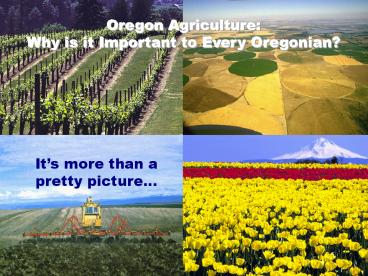Presentation - PowerPoint PPT Presentation
1 / 20
Title:
Presentation
Description:
2 Grass seed $ 507 million. Oregon grass seed is ranked second, with a ... Grass seed (ryegrass, fescue, and orchardgrass) Christmas trees. Dungeness crab ... – PowerPoint PPT presentation
Number of Views:53
Avg rating:3.0/5.0
Title: Presentation
1
Oregon Agriculture Why is it Important to Every
Oregonian?
Its more than a pretty picture
2
Its all about Agriculture! Economic Contribution
- Total farm sales in 2007 topped 5 billion for
the first time. - Farmers purchase over 3 billion in goods/inputs
to grow their crops and livestock - a huge
stimulus to Oregons economy. - Value-added processing contributes another 1.5
to 2 billion in revenues to the states economy.
3
1 Greenhouse and nursery 1.04 billion
- Oregons number one commodity, nursery and
greenhouse sales, totaled 1.039 billion in 2007. - This marks a 7.6 percent increase from 2006 and
the 18th consecutive year of record sales.
4
2 Grass seed 507 million
- Oregon grass seed is ranked second, with a value
of 507 million. - Oregon is the nations top producer of high
quality grass seed such as ryegrass, fescue, and
orchardgrass.
5
3 Cattle and calves 465 million
- Oregons third ranked commodity is valued at 465
million. - Cattle and calf prices have been down for the
last several years and production values
decreased 5 since 2006. - Top production counties are Malheur, Harney,
Baker, Morrow, Lake, and Umatilla counties.
6
4 Hay 459 million
- Hay is the fourth ranked agricultural commodity
in Oregon. - Alfalfa production totaled 1.64 million tons,
down 13 percent from 2006. - All hay production totaled almost 3 million tons
in 2007.
7
5 Dairy 408 million
- The Oregon dairy industry holds fifth place in
the states agricultural commodities ranking,
over 408 million was the production value for
milk alone in 2007. - Total milk production value for the state
increased 24 percent in 2007. - Production per cow and other efficiencies
continue to grow, and production value continues
to increase despite a 3 percent drop in the
number of milk cows in 2007.
8
Rounding out Oregons top ten agricultural
commodities list
- 6. Wheat, 360 million
- 7. Potatoes, 146 million
- 8. Christmas trees, 114 million
- 9. Pears, 84 million
- 10. Wine grapes, 68 million
9
Agricultural diversity
- Oregon is known for its wide variety of
top-quality agricultural products. Over
220 commodities are grown in Oregonmore than in
any state other than California. - It is this diversity of products that helps
Oregon maintain a strong agriculture industry,
even when some commodities face tough economic
challenges.
10
Oregon leads the nation in the production of
- Hazelnuts
- Blackberries, Loganberries, Black raspberries,
boysenberries - Grass seed (ryegrass, fescue, and orchardgrass)
- Christmas trees
- Dungeness crab
- Sugarbeets for seed
- Crimson clover and red clover seed
- Dried herbs
11
Oregon ranks second nationally in the production
of
- Peppermint and Spearmint
- Hops
- Sweet cherries
- Red raspberries
- Potted florist azaleas
- Winter peas
- Snap beans
- Nursery crops
12
Oregon ranks third nationally in the production
of
- Strawberries
- Kentucky bluegrass seed
- Pears
- Blueberries
- Mink
- Onions
13
Agriculture population
- Agriculture in Oregon exists side-by-side with
Oregons growing population. - The states top five agricultural counties are
located within an hours drive of Oregons three
largest cities Portland, Salem, and Eugene.
14
Agricultural workforce
- People really make up the industry.
- Oregons on-farm employment is crucial, and the
50,000 on-farm workers are recognized as very
important to the industry and the state. - All agricultural related industries in Oregon,
including food processing, make up over 150,000
jobs.
15
Agricultural Economics 101
- Adding all agriculture-related components
(inputs, production, processing, transportation,
warehousing, wholesale trade) accounts for over
25.8 billion in economic activity, or 10.6 of
Oregons Gross State Product (GSP) and more than
10 of all employment.
16
Farm ownership
- 88 percent of Oregon farms are owned or operated
by individual families. - Of the states 38,300 farms, an additional 8-10
percent are structured as family partnerships or
family corporations. - 1,082 farms have been recognized under the
Century Farm and Ranch Program for being in the
same family for over 100 years.
17
Oregons farmers
- The average age of farmers and ranchers in Oregon
is 54.9. - Within the next decade, at least 30 percent of
the states farmers and ranchers will retire and
much of Oregons farmland will change ownership.
18
Oregon exports
- 80 percent of the agricultural products produced
in Oregon are shipped out of state. - Roughly 40 percent of Oregons production is
exported out of the country.
19
Stewards of the land
- Oregon farmers and ranchers have 600,000 acres in
conservation reserve programs and provide habitat
year-round for over 70 percent of the states
wildlife. - Erosion on crop and range land has been reduced
by more than 35 percent in the past decade due to
changes in practices by Oregon farmers and
ranchers. - Oregon leads the nation in the number of water
right transfers used for conservation and
wildlife preservation.
20
Sustainable resources
- Oregon producers are exploring sustainable energy
resources including wind, biomass digestors,
biofuels, solar, and other technologies. - These advances can bring renewable energy to
urban areas and jobs and economic development
across the state.































